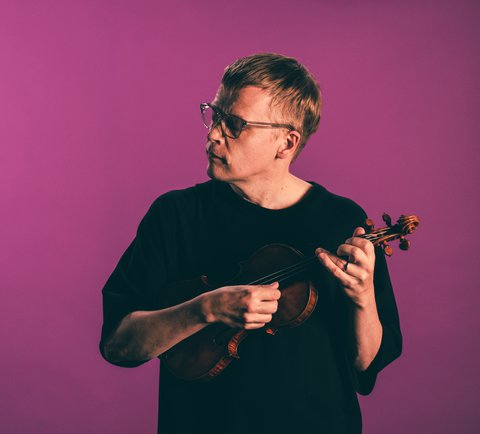The Finnish violinist takes the reins himself: Pekka Kuusisto leads the Mahler Chamber Orchestra as soloist and concert master. In the interview, he gives a foretaste of the concert on Sept. 23 2023 in the auditorium at the University Palace.
5 Questions for ...
Violinist Pekka Kuusisto

1. Who is Beethoven to you?
I see Beethoven as a divider in perspectives of how we approach music in general. I have the feeling that historically, before Beethoven, revolution was not something that an average central European person thought about very much. Beethoven’s music helped to change that. I find it comparable to the arrival of rock’n’roll. There was something about Beethoven himself that helped – he lacked respect for some traditional forms, he didn’t have a problem blowing up the old. I am, of course, nowhere near as bold and as daring as Beethoven was. But I find his company very encouraging when I feel that the world is stuck and that our way of making and approaching music needs a refreshing explosion.
2. What was important to you when putting together the concert programme for your performance with Mahler Chamber Orchestra?
One way to look at the programme would be to see it as rethinking concert culture and concert conventions. The piece by Thomas Adès is a wonderful reworking of music by Couperin. Haydn’s »Farewell« Symphony – well, today’s audiences know what happens at the end. Everyone knows that the orchestra walks out. But it is still quite a striking, rather revolutionary experience. Also for the fact that it is political, it’s the most beautiful music ever written to champion workers’ rights. Haydn wanted to tell his boss, Nikolaus Esterházy, that the orchestra musicians deserved a vacation.
Missy Mazzoli’s piece is a comment on the D Minor Chaconne by Bach. It’s not as close to the Bach as the Adès work is to Couperin’s original, but the idea is the same: to take an element of older and established music, and to reshape that into new music. I believe that we, in concert culture, are quite behind on that when you compare us to the theatre for example, where they’re always reworking and reinventing the classics. Because in the orchestral world we normally put the concert together in just a couple of days, there is no time to improvise and rewrite things.
3. Beethoven’s Violin Concerto has been interpreted very often and by all the great violinists. What makes the piece exciting for you?
there is some mystery surrounding the birth of the concerto. We don’t have a definitive solo part for the concerto written by Beethoven. There exists a manuscript score that contains a violin part. A long time ago, when I first saw this manuscript, I was surprised because you immediately see that in many places there are several versions of the solo violin line – sometimes three, sometimes four. Beethoven wrote them at different times, using different pens. For some years now I have studied the manuscript and I have chosen my own favourite additions from it in places where there are variants. So I have taken my favourite moments from this manuscript and have included them in my solo part. Approximately 10 per cent of the concerto will sound a little different to what audiences are used to hearing.
Performing this version is a slightly risky thing to do, because I am not looking to irritate. I don’t want to say that what I do is right and what other people do is wrong. But because of this particular concert programme, with the ideas of reshaping existing music and trying to re-understand the concert situation, I think it’s a great opportunity to remember that music performance was so different during Beethoven’s time. Elements such as improvisation and the structure of concerts were nothing like what we see today. So in a way the manuscript score by Beethoven is a fantastic gift for people who want to feel that the concerto is still alive.
4. You are the artistic partner of the Mahler Chamber Orchestra. What is special about working with this orchestra?
Mahler Chamber is one of the really beautiful examples of how an orchestra’s character, when it’s strong, endures. I never had the fortune of meeting conductor Claudio Abbado, who is considered the founder of the orchestra. From what I understand from my colleagues in the orchestra, the spirit of comradeship and the flexible, smiling, quite adventurous musicianship is something that he began building and that today defines the nature of the Mahler Chamber Orchestra. They are incredibly gifted musicians and very skilled players, but there’s something quite special about the chemistry in the orchestra that makes them extremely fun and warm to be on stage with. They are not trying to be cool, they are trying to be warm, which I find a lovely thing to do.
5. What is it like to lead an orchestra as a soloist and concertmaster? How does this affect you as a violinist?
It does affect my playing quite a lot. Something like the Beethoven Violin Concerto, for instance, is quite a long piece and requires, at least for me, a very elegant and effortless way of handling the instrument. I don’t want it to sound like a struggle when I play, it has to flow like water. To achieve that, the easiest way is just to be as relaxed and focused on the movements the instrument requires. But when you lead an orchestra, you have to be 50 per cent conductor as well. So it’s not always completely easy. But I do love the immediate connection, the way an orchestra will listen and watch and take extra responsibility when there is no conductor. I have been working quite a lot lately as a conductor myself. One of my main dreams as a conductor is to not lose that feeling when conducting, the chamber music spirit should still be there.
Pekka Kuusisto at Beethovenfest 2023
- , University of Bonn, Aula
Mahler Chamber Orchestra & Kuusisto
Mahler Chamber Orchestra, Pekka Kuusisto
Beethoven, Adès, Haydn
